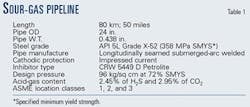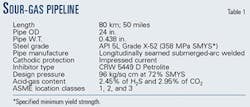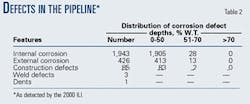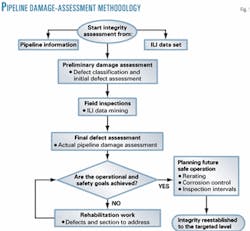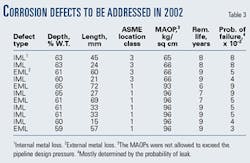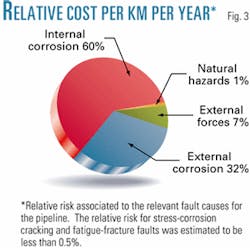Damage assessment by in-line inspection and rehabilitation of a sour-gas pipeline in Mexico revealed, among other findings, that ILI data are not always accurate and that metal loss by corrosion was the principal integrity issue.
The program determined that future safe operation of the pipeline required limiting its throughput to 200 MMscfd and maintaining a continuous fluid regime in order to mitigate hydrogen-induced cracking (HIC). No rerating was deemed necessary for the next 10 years.
Described here are the damage assessment and rehabilitation of the Ciudad Pemex-La Isla 24-in. sour gas pipeline managed and operated by Petróleos Mexicanos SA (Pemex). The assessment of the pipeline derived from data on the pipeline's defects gathered with magnetic flux leakage (MFL) in-line inspection (ILI) devices ("pigs") and field external nondestructive measurements.
Assessment of the reduction in safety from mechanical and weld defects proceeded according to fitness-for-service procedures compiled in API Recommended Practice 579. Corrosion defects were assessed with deterministic approaches given in the modified ASME B31G code as well as through structural reliability studies.
Risk analyses also established a priority scheme for the rehabilitation program.
In-line inspection
Although both efficient and safe means to transport energy, pipelines are inevitably subject to damage their operational lifetime that may impair their structural reliability. Therefore, risk-based integrity assessments and cost-effective rehabilitation must become an important part of all pipe line management programs, notably for ageing oil and gas transportation pipe lines.1
In-line inspection has proven effective in detecting, identifying, and sizing mechanical, weld, and corrosion defects on in-service pipelines. ILI has become the most important source of reliable information for monitoring and management of pipeline risk.1
ILI data allow prediction of corrosion severity and permit corrosion rates to be estimated with a measurable level of confidence. Defects' significance can thereby be assessed for determination of maximum allowable operating pressure (MAOP) and remaining service life of the pipeline.
At the same time, ILI provides basic information for implementing risk-based management programs aimed at scheduling optimal reinspection intervals, corrosion-growth-rate control measures, rerating strategies, and rehabilitation actions.
Most pipelines in Mexico are designed under working-stress design codes. In the last decade, integrity concerns related to the reduction in safety in ageing oil and gas transportation lines with mechanical and weld defects have been addressed with well established fitness-for-service principles based on fracture mechanics developed independently by the Pipeline Integrity Assessment Group (GAID) of the National Polytechnic Institute in Mexico through collaboration with Pemex.
Recently, most of these methods were compiled, categorized, and described in API RP 579.2
On the other hand, corrosion defects have been mostly assessed with such deterministic approaches as those in ASME B31G and modified B31G codes.3 4 Finite-element stress analyses have been used in some special cases.
In recent years, this process has incorporated structural reliability analysis to improve the accuracy of the assessment of corrosion defects.5
The uncertainty analysis of the variables that determine both the failure pressure and remaining life of a pipeline allows computation of the probability of failure associated with corrosion defects.
The approach to acceptance in this type of analysis is to use target reliability levels the pipeline must meet. This latter approach excludes consequences explicitly, but in most cases the reliability target levels derive from risk analyses or from historical failure databases.
In Mexico, risk analysis is increasingly recognized as the most significant approach for effectively prioritizing the use of finite resources to minimize pipeline hazards.
Recent risk-based assessments of the condition of pipelines in Mexico6 have proven the usefulness of this approach to achieve efficient inspection, repair, and maintenance programs that enhance the return on investment.
This article describes a case study in which ILI data have been used together with fitness-for-service procedures, structural-reliability analysis, and risk analysis to assess the condition of a 24-in. onshore sour-gas pipeline managed and operated by Pemex.
This integrity assessment allowed determination of the actual MAOP and remaining life of this pipeline according to its measured population of mechanical and active corrosion defects.
In addition, the results were used in a cost effective, risk-based rehabilitation program that reestablished the integrity of the pipeline at targeted MAOP and remaining life of 65 kg/sq cm and 8 years, respectively.
Condition assessment
Fig. 1 illustrates the approach used to assess the integrity of the pipeline. The design and operational information of the pipeline is combined with the ILI data set to carry out a preliminary damage assessment.
The reliability of the ILI tool is investigated, and the resulting actual sizes of the features are used to conduct the final damage assessment, which determines the extent of the rehabilitation work required to reestablish the integrity of the pipeline according to the required operational and safety levels. Defects or pipeline segments are repaired until the operational and safety goals are achieved.
Finally, the strategies for future safe operation of the pipeline are established. This latter stage is mainly based on the predicted evolution with time of both the probability of failure and the corresponding risk level.
The following sections detail each step in Fig. 1.
Pipeline information. The Ciudad Pemex-La Isla 24 in., 80-km (50 mile) pipeline is a 25-year-old sour gas transportation system operated and managed by Pemex-CGTO (Cordinacion de la Gerencia Tecnica Operativa).This pipe line began operating in 1975 and until 1985 transported natural gas produced in wells in the Cactus region in Southeast Mexico.
From 1985 to 1999, it conveyed sour gas produced in Campeche Bay at 400 MMscfd.In early 2000, Pemex authorities decided to reestablish the integrity of this pipeline to 65 kg/sq cm MAOP. Achieving this goal required a careful condition assessment based on state-of-the-art technologies and analytical tools followed by rehabilitation.Table 1 gives the basic information for the Ciudad Pemex-La Isla pipeline.
ILI data sets. The pipeline was inspected in 1995 and again in 2000 with second-generation MFL tools.The 1995 inspection revealed metal loss caused by external corrosion (163 features) representing the main integrity concern, followed by metal loss from internal corrosion (72 features). All these defects showed relative depths less than 70% W.T. This inspection also revealed that mechanical defects represented a very low fraction of the flaws detected in the inspection.Table 2 lists the summary of results of the ILI conducted in 2000. The depth-of-corrosion features illustrate the extent of the damage in the pipeline.
The data in this table show that internal corrosion became the main integrity issue in 2000.Although the number of internal features greatly increased from 1995 to 2000, the majority of these defects (about 98%) showed relative depths of less than 30% W.T. The increase in the number of defects due to external corrosion from 1995 to 2000 was less remarkable because in 1996, based on the results of the ILI conducted in 1995, the pipeline cathodic-protection system was significantly improved.
Initial damage assessment. Fig. 1 shows that the ILI data sets were used as input for the preliminary damage assessment of the pipeline. The features detected by the inspection tool were initially assessed according to the size predicted by the inspection tool.Mechanical and weld defects were assessed with methods given in API 579. Their reduced number permitted field inspection of them all. Corrosion defects were assessed with the method given in the modified B31G code. At this stage, the damage due to corrosion included determination of the MAOP and remaining life of the pipeline. Based on the results of the preliminary damage assessment, a representative number of defects selected at random regardless of their severity were field inspected with ultrasonic nondestructive technology. Fig. 2 shows unit plots comparing depths predicted by the ILI tool to actual depths obtained by field-measurements for corrosion metal losses. The fractions of correlation points that fall into the region defined by the blue error bars in Figs. 2a and 2b were close to 62% and 70% for internal and external defects, respectively.
These fractions are smaller than those corresponding to the accuracy commonly stated by the inspection companies, that is, depth errors close to ±10% W.T. 80% of the time. As measured by the random errors shown in Fig. 2, the true accuracy of the ILI tool for corrosion depths is better approximated as ±20% W.T. 95% of the time. No systematic (bias) errors were detected in the ILI data sets.
- Final assessment; rehabilitation. The final damage assessment estimated no severity of defects in the pipeline from their size corrected with the results of the comparison of the ILI runs with field measurements.
In addition to the MAOP and remaining life imposed by the presence of the detected mechanical and corrosion features, this stage included the estimation of the probability of failure and risk associated with each failure mode both for the entire pipeline and on a per-kilometer basis.
The probability of failure associated with each defect was computed by combining the probability of failure due to the limit-state function for bursting and rupture and that due to the limit-state function for leak.5
Fig. 3 shows the relative risk associated with different fault causes represented on a kilometer-per-year basis. Corrosion, notably internal, was estimated as the most severe failure cause with respect to risk for this pipeline.
Outside forces and ground movements (natural hazards) have associated risk levels significantly higher than those related to structural, construction, material, stress corrosion cracking (SCC), and fatigue or rupture faults.
Because the flaws with the smaller MAOP and remaining life determine the actual MAOP and remaining life of the entire pipeline, the results of the final damage assessment revealed that a total of 26 defects had to be addressed.
The iterative approach outlined in Fig. 1 was employed during rehabilitation in order to achieve the targeted MAOP (65 kg/sq cm) and remaining life (8 years). The addressed defects included 14 internal and 8 external metal losses caused by corrosion, 2 weld defects, and 2 construction or material defects.
In most cases, metal losses were repaired using Clock Spring and compression steel sleeves. In addition to these repairs, three sectioning valves were replaced.
Future strategies
The extent of the rehabilitation program was at first determined by the purpose of achieving the targeted integrity level in a relative short time. The damage assessment revealed, however, that other defects must be addressed in 2002 to meet the acceptance criteria demanded for the MAOP, remaining life, and probability of failure of the pipeline.
Table 3 lists the most severe corrosion defects that must be addressed in 2002. The four defects with ASME Location Class 3 constitute the major integrity concern at present.
All these defects, however, have associated failure probabilities greater than the commonly recommended target failure probability for gas pipelines with respect to life safety and economic optimization criteria which is of 10-4 - 10-7/km/year.7
It should be also mentioned that the probabilities of failure associated with them are completely determined by the probability of leak.
Once the defects listed in Table 3 have been repaired, the optimal reinspection interval for the assessed pipe line will be close to 3 years.
This is the time required for it to reach a failure probability of 10-5/km/ year.
This target reliability level is the average value recommended for the design of gas and high-pressure vapor pipelines for a societal risk of 10-7/person/year.7
Other recommendations for the safe future operation of the pipeline derived from this integrity-assessment study included limiting throughput of the line to 200 MMscfd and maintaining a continuous fluid regime to mitigate hydrogen induced cracking (HIC) produced by water sedimentation.
No rerating actions were foreseen for the next 10 years.
Acknowledgments
This work was done under the collaboration agreement PEPRES ACTO 001/00 between Pemex-PEP-RS and the Instituto Polit
References
The authors
José Manuel Hallen López is a professor at Instituto Politécnico Nacional (IPN), Mexico, and cofounder of the Pipeline Integrity Assessment Group of the IPN. He holds a PhD (1990) in metallurgy from the University of Montreal.
Jorge L. González is a professor in the metallurgy department of IPN and works in the field of fracture mechanics and pipeline integrity assessment technologies. He founded and heads the Pipeline Integrity Assessment Group of the IPN. He holds BS and MSc degrees in metallurgy from IPN and a PhD in material science from the University of Connecticut.
Francisco Caleyo joined the Pipeline Integrity Analysis Group of the IPN in 1999 where he heads a research team involved with the development and application of structural reliability analysis techniques on onshore and offshore pipelines. He holds a BS in physics and an MSc in materials science from Universidad de La Habana, Cuba, and a PhD (2001) in materials science from Universidad Aut
Francisco Fernández-Lagos is maintenance vice-manager at the Gerencia de la Coordinación Técnica Operativa Región Sur, Pemex Exploración y Producci
